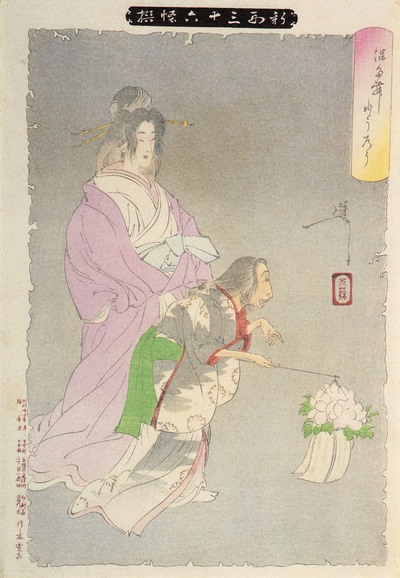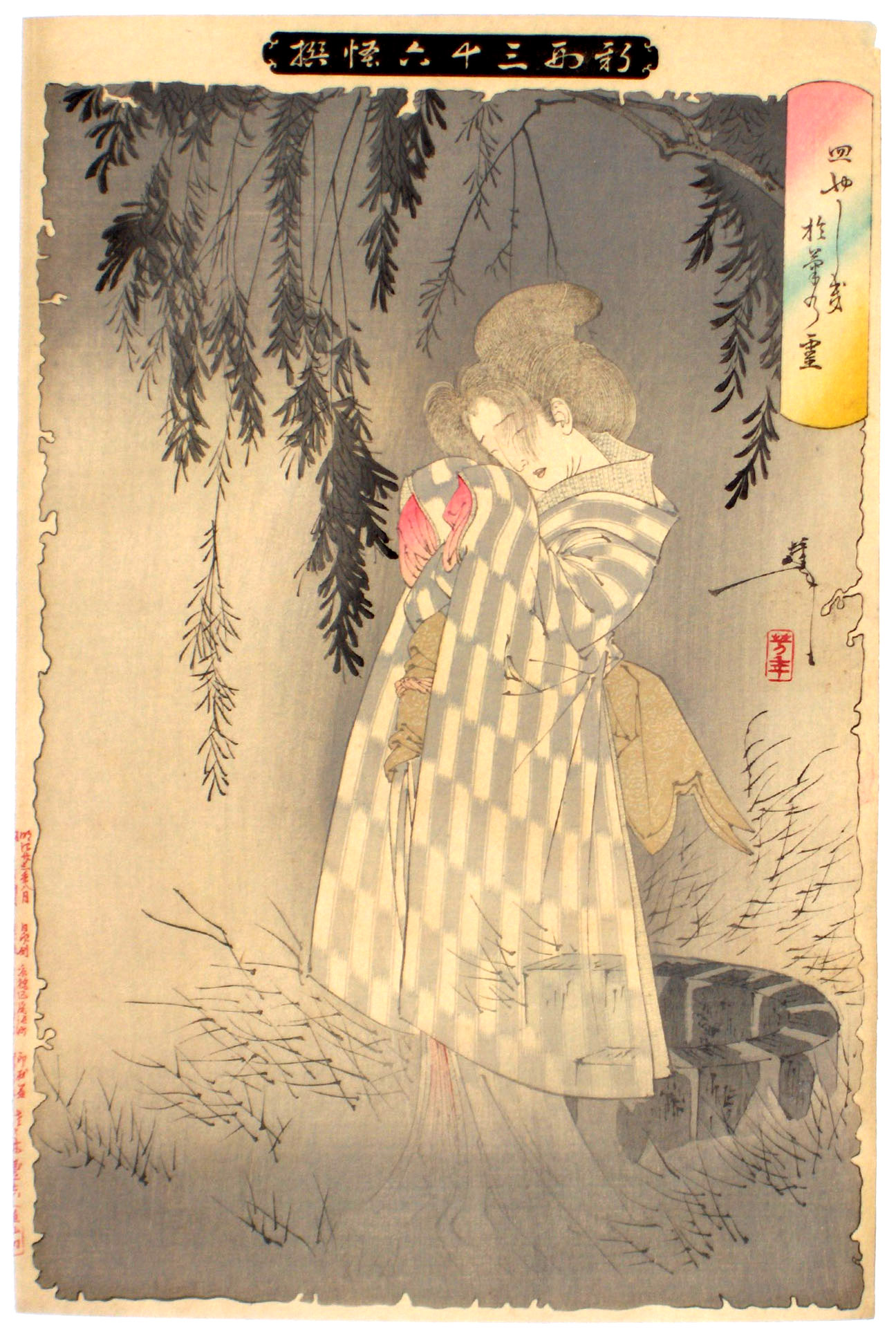|
Kaidan
is a Japanese language, Japanese word consisting of two kanji: 怪 (''kai'') meaning "strange, mysterious, rare, or bewitching apparition" and 談 (''dan'') meaning "talk" or "recited narrative". Overall meaning and usage In its broadest sense, ''kaidan'' refers to any ghost story or horror fiction, horror story, but it has an old-fashioned ring to it that carries the connotation of Edo period Japanese folktales. The term is no longer as widely used in Japanese as it once was: Japanese horror books and films such as ''Ju-on'' and ''Ring (film), Ring'' would more likely be labeled by the ''katakana'' . ''Kaidan'' is only used if the author/director wishes to specifically bring an old-fashioned air into the story. Examples of ''kaidan'' *''Banchō Sarayashiki'' (''The Story of Okiku'') by Okamoto Kido *''Yotsuya Kaidan'' (''Ghost Story of Tōkaidō Yotsuya'') by Tsuruya Nanboku IV (1755–1829) *''Botan Dōrō'' (''The Peony Lantern'') by Asai Ryoi *''Hōichi the Earless, Mimi-na ... [...More Info...] [...Related Items...] OR: [Wikipedia] [Google] [Baidu] |
Hyakumonogatari Kaidankai
was a popular didactic Buddhism, Buddhist-inspired parlour game during the Edo period in Japan. Play The game is played after nightfall in one of two ways. The simplest form involves participants sitting in a circle in a room where 100 Traditional lighting equipment of Japan#Andon, andon lamps or candles are lit. As participants take turns telling ghost stories and tales of the supernatural, a lantern is snuffed out after each story, causing the room to become darker and darker as the night and the game progress. A second variation integrates elements of a kimodameshi "test of courage" into the game. Rather than one room, three connected rooms are used. In one of the end rooms, 99 andon lamps or candles are lit, and a small mirror positioned on a table. Guests gather in the other end room, with the 100th lamp. The center room remains empty and unlit. Ideally, the rooms are arranged in an L-shape so guests can see the light from the lantern room, but have no direct line of ... [...More Info...] [...Related Items...] OR: [Wikipedia] [Google] [Baidu] |
Yotsuya Kaidan
, the story of Oiwa and Tamiya Iemon, is a tale of betrayal, murder and onryou, ghostly revenge. Arguably the most famous Kaidan (parapsychology), Japanese ghost story of all time, it has been adapted for film over 30 times and continues to be an influence on Japanese horror today. Written in 1825 by Tsuruya Nanboku IV as a kabuki play, the original title was . It is now generally shortened, and loosely translates as ''Ghost Story of Yotsuya.'' History First staged in July 1825, ''Yotsuya Kaidan'' appeared at the Nakamuraza Theater in Edo (the former name of present-day Tokyo) as a double-feature with the immensely popular ''Forty-seven Ronin, Kanadehon Chushingura''. Normally, with a Kabuki double-feature, the first play is staged in its entirety, followed by the second play. However, in the case of ''Yotsuya Kaidan'' it was decided to interweave the two dramas, with a full staging on two days: the first day started with ''Kanadehon Chushingura'' from Act I to Act VI, followed ... [...More Info...] [...Related Items...] OR: [Wikipedia] [Google] [Baidu] |
Ugetsu Monogatari
is a collection of nine supernatural tales first published in 1776. It is the best known work of Japanese author Ueda Akinari. Largely adapted from traditional Japanese and Chinese ghost stories, the collection is among the most important works of Edo period (1603–1867) and literature, and is considered a predecessor of the genre. Kenji Mizoguchi's award-winning film (1953), credited with helping popularize Japanese cinema in the West, was adapted from two of the collection's stories. Title The word is a compound word; means "rain", while translates to "moon". It derives from a passage in the book's preface describing "a night with a misty moon after the rains", and references a Noh play, also called , which also employs the common contemporary symbols of rain and moon. These images evoked the supernatural and mysterious in East Asian literature; Qu You's (; a story from , one of Ueda's major sources), indicates that a rainy night or a morning moon may presage the ... [...More Info...] [...Related Items...] OR: [Wikipedia] [Google] [Baidu] |
Ghost Story
A ghost story is any piece of fiction, or drama, that includes a ghost, or simply takes as a premise the possibility of ghosts or characters' belief in them."Ghost Stories" in Margaret Drabble (ed.), ''Oxford Companion to English Literature''. Oxford, Oxford University Press, 2006. (p. 404-5). The "ghost" may appear of its own accord or be summoned by magic. Linked to the ghost is the idea of a "haunting", where a supernatural entity is tied to a place, object or person. Ghost stories are commonly examples of ghostlore. Colloquially, the term "ghost story" can refer to any kind of scary story. In a narrower sense, the ghost story has been developed as a short story format, within genre fiction. It is a form of supernatural fiction and specifically of weird fiction, and is often a horror story. While ghost stories are often explicitly meant to scare, they have been written to serve all sorts of purposes, from comedy to morality tales. Ghosts often appear in the narrative a ... [...More Info...] [...Related Items...] OR: [Wikipedia] [Google] [Baidu] |
Botan DĹŤrĹŤ
is a Japanese ghost story () and one of the most famous in Japan. The plot involves sex with the dead and the consequences of loving a ghost. It is sometimes known as , based on the kabuki version of the story; this title is commonly used in translation, and refers to a Stone Lantern. History entered Japanese literary culture in the 17th century, through a translation of a book of Chinese ghost stories called (''New Tales Under the Lamplight'') by Qu You. The collection was didactic in nature, containing Buddhist moral lessons on karma. In 1666, author Asai Ryoi responded to the Edo period craze for , spawned largely by the popular game , by adapting the more spectacular tales from into his own book (''Hand Puppets''). At the time, Japan's borders were entirely closed, with very little of the outside world known by its people; as such, China was viewed as a mysterious and exotic nation. Asai removed the Buddhist moral lessons and gave the stories a Japanese setting, ... [...More Info...] [...Related Items...] OR: [Wikipedia] [Google] [Baidu] |
BanchĹŤ Sarayashiki
is a Kaidan, Japanese ghost story (kaidan) of broken trust and broken promises, leading to a dismal fate. Alternatively referred to as the tradition, all versions of the tale revolve around a servant, who dies unjustly and returns to haunt the living. Some versions take place in or , others in the area in Edo. History The story of the death of Okiku () first appeared as a bunraku play called ''BanchĹŤ Sarayashiki'' in July 1741 at the Toyotakeza theater. The familiar Kaidan (parapsychology), ghost legend had been adapted into a ''Bunraku, ningyĹŤ jĹŤruri'' production by Asada Iccho and Tamenaga Tarobei I. Like many successful bunraku shows, a kabuki version followed and in September 1824, ''BanchĹŤ Sarayashiki'' was staged at the Naka no Shibai theater starring Otani Tomoemon II and Arashi Koroku IV in the roles of Aoyama Daihachi and Okiku. A one-act kabuki version was created in 1850 by Segawa Joko III, under the title ''Minoriyoshi Kogane no Kikuzuki,'' which debuted a ... [...More Info...] [...Related Items...] OR: [Wikipedia] [Google] [Baidu] |
Japanese Horror
Japanese horror, also known as J-horror, is horror fiction derived from popular culture in Japan, generally noted for its unique thematic and conventional treatment of the horror genre differing from the traditional Western representation of horror. Japanese horror tends to focus on psychological horror, tension building (suspense), and the supernatural, particularly involving ghosts (''yūrei'') and poltergeists. Other Japanese horror fiction contains themes of folk religion such as possession, exorcism, shamanism, precognition, and ''yōkai''. Media in which the genre of Japanese horror fiction can be found include artwork, theater, literature, film, anime and video games. Origins The origins of Japanese horror can be traced back to the horror fiction and ghost stories of the Edo period and the Meiji period, which were known as '' kaidan'' (sometimes transliterated ''kwaidan''; literally meaning "strange story"). Elements of these popular folktales have routinely been use ... [...More Info...] [...Related Items...] OR: [Wikipedia] [Google] [Baidu] |
Ju-on
is a Japanese horror media franchise, franchise created by Takashi Shimizu. The franchise began in 1998 with the release of the short films Katasumi and 4444444444, ''Katasumi'' and ''4444444444''. Shimizu attended the Film School of Tokyo, where he studied under Kiyoshi Kurosawa. Kurosawa helped Shimizu shepherd the ''Ju-On'' projects to fruition. The ''Ju-On'' films generally revolve around a curse created in a house in Nerima, Tokyo, when Takeo Saeki, convinced that his wife, Kayako Saeki, Kayako, is having an affair with another man, murders her, their son, Toshio Saeki, Toshio, and Toshio's pet cat in a jealous fit of rage. According to ''Ju-On'', when a person dies with a deep and powerful rage, a curse is born. The curse gathers in the place where that person has died or which they frequented, and repeats itself there. The spirits of the deceased haunt the location, potentially killing anyone who encounters the curse by any means, such as entering a cursed house or bein ... [...More Info...] [...Related Items...] OR: [Wikipedia] [Google] [Baidu] |
Parlour Game
A parlour or parlor game is a group game played indoors, named so as they were often played in a parlour. These games were extremely popular among the upper and middle classes in the United Kingdom and in the United States during the Victorian era. The Victorian age is sometimes considered the "Golden Age" of the parlour game.Beaver, Patrick (1978). ''Victorian Parlor Games'', p.14. T. Nelson. . During the 19th century, the upper and middle classes had more leisure time than people of previous generations. This led to the creation of a variety of parlour games to allow these gentlemen and ladies to amuse themselves at small parties. Boxed parlour games were very popular from around 1920 until into the 1960s, especially around Christmas. Parlour games competed for attention with the mass media, particularly radio, film, movies, and television. Though decreased in popularity, parlour games continue to be played. Some remain nearly identical to their Victorian ancestors; others h ... [...More Info...] [...Related Items...] OR: [Wikipedia] [Google] [Baidu] |
Printing Press
A printing press is a mechanical device for applying pressure to an inked surface resting upon a printing, print medium (such as paper or cloth), thereby transferring the ink. It marked a dramatic improvement on earlier printing methods in which the cloth, paper, or other medium was brushed or rubbed repeatedly to achieve the transfer of ink and accelerated the process. Typically used for texts, the invention and global spread of the printing press was one of the most influential events in the second millennium. In Germany, around 1440, the goldsmith Johannes Gutenberg invented the movable type, movable-type printing press, which started the Printing Revolution. Modelled on the design of existing screw presses, a single Renaissance movable-type printing press could produce up to 3,600 pages per workday, compared to forty by History of typography in East Asia, hand-printing and a few by scribe, hand-copying. Gutenberg's newly devised hand mould made possible the precise and rapi ... [...More Info...] [...Related Items...] OR: [Wikipedia] [Google] [Baidu] |
China
China, officially the People's Republic of China (PRC), is a country in East Asia. With population of China, a population exceeding 1.4 billion, it is the list of countries by population (United Nations), second-most populous country after India, representing 17.4% of the world population. China spans the equivalent of five time zones and Borders of China, borders fourteen countries by land across an area of nearly , making it the list of countries and dependencies by area, third-largest country by land area. The country is divided into 33 Province-level divisions of China, province-level divisions: 22 provinces of China, provinces, 5 autonomous regions of China, autonomous regions, 4 direct-administered municipalities of China, municipalities, and 2 semi-autonomous special administrative regions. Beijing is the country's capital, while Shanghai is List of cities in China by population, its most populous city by urban area and largest financial center. Considered one of six ... [...More Info...] [...Related Items...] OR: [Wikipedia] [Google] [Baidu] |








